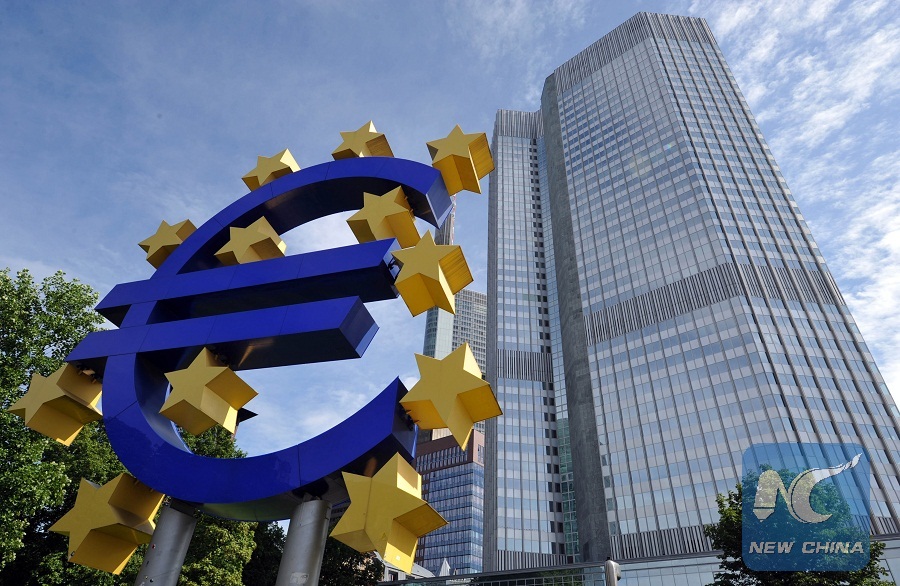
Xinhua File Photo
by Shen Zhonghao
FRANKFURT, Sept. 13 (Xinhua) -- Given positive economic data over the past year or so, Europe is recovering from the worst financial crisis in decades.
However, despite encouraging signs that have become increasingly visible since the beginning of this year, observers said it is largely related to a cyclical recovery rather than strong, balanced and sustainable growth.
WHERE'S THE SUSTAINABLE GROWTH?
The European economy has entered its fifth year of recovery, which is reaching all European Union (EU) Member States, the European Commission summarized in its Spring Economic Forecast, expecting that the recovery would continue at a largely steady pace this year and next.
With private consumption consistently boosting growth and foreign trade expanding moderately, the annual Gross Domestic Product (GDP) growth of the EU is expected to reach 1.9 percent this year, according to a European Commission projection, which shows improving sentiment.
There is no doubt that after years of crisis, Europe has successfully entered a broad-based cyclical recovery, which is confirmed by encouraging data like a declining unemployment rate, a growing headline inflation rate etc. However, it is widely believed that Europe's economic potential remains below its pre-crisis level.
Struggling to tackle the financial crisis for almost a decade, the EU has not achieved a credible return to economic vigor, said Maria Demertzis, deputy director at EU think tank Bruegel.
"It is true that Europe has seen some renewed growth recently, but it remains weak and precarious," she said in a recently published article.
Germany's economic growth, the largest economy in Europe, appears to be on solid footing but remains unreliable.
"The robust cyclical upswing is masking the creeping erosion of growth," Deutsche Bank said in a research report released last month, warning that by 2025 Germany's trend growth looks set to halve to only 0.75 percent.
In Italy, where one third of youths remain unemployed, just 6 percent of people expressed optimism for future growth, according to one report.
LAME-DUCK POLICY
The ultra-loose monetary policy by the European Central Bank (ECB) has succeeded in preserving the euro, preventing the single currency union from collapse, long-term recession and deflation, since ECB President Mario Draghi claimed "whatever it takes..." in the summer of 2012.
The package of accommodative monetary policy tools, both conventional and unconventional, including a zero interest rate plus massive asset purchases of over two trillion euro (2.4 trillion U.S. dollars) as of August, have been working in the euro area, yet made the recovery addicted to cheap money provided by Eurosystem, so that the ECB is still lack of confidence to taper quantitative easing.
Monetary policy alone would not be enough to jump-start the economy, Draghi said, urging the fiscal policy as well as structural reforms both at the EU level and national level to accelerate.
In fact, investment has contributed far less to growth in Europe in context of ongoing de-leveraging and fiscal consolidation.
The business investment ratio in the euro area is currently around 15 percent, much lower than the level at the beginning of 2009, while the public debt ratio of the eurozone has risen to 89.5 percent as of the first quarter of 2017, which anchored many countries to the dilemma of cutting the deficit and expanding investment.
"The improving near-term outlook is clouded by significant downside risks, especially in the medium and long term, amidst thin policy buffers," according to the IMF Staff Report concerning the eurozone policy which was released in July.
The IMF urged that high-debt countries with relatively less fiscal space, like Italy, France and Portugal, should consolidate to put debt firmly on a downward path and to rebuild buffers.
Not only subdued investment dynamics but also sluggish structural reforms, the key to solving structural problems, have led to chronically slow growth of productivity in Europe.
"Europe has experienced a two-decade long decline in competitiveness," the European Investment Bank (EIB) said in a report.
"This trend has undermined the comparative ability of European firms to compete and to provide rewarding jobs and a high standard of living," the EIB underlined in its report.
DEEP-ROOTED PROBLEMS
Observers said Europe has failed to upgrade its economic recovery towards solid, sustainable and balanced growth, mainly due to lack of strong determination as well as underpinning of consistent, effective and coordinated policies, which reflects more deep-rooted problems that have been troubling Europe for long time.
Electoral systems in Europe make many politicians focus too much on ballots rather than governance, which may delay or even hinder reforms.
Although the elites in Europe are aware of the deep-rooted "social ills," they are not determined to take painful reforms.
As a result, the market didn't work well when problems arose.
For example, elite class solidification, or the growing gap between the elite and middle classes, is considered to be the root of a variety of problems in France, said Luc Rouban, a researcher with the Center of Political Research of Science Po.
"The interest groups who manipulate 'state apparatus' care much for the steadiness of the political system, not willing to see much change in this regard, which make reforms even more difficult," he added.

